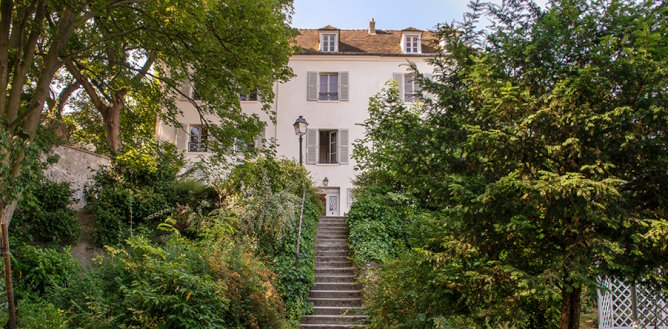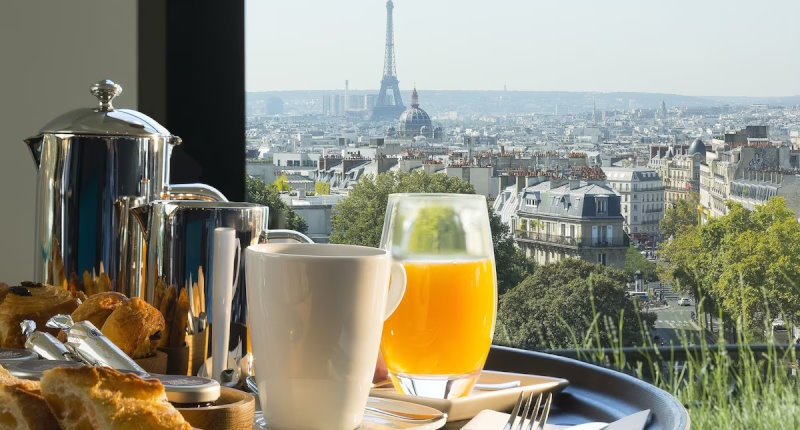Montmartre Museum Renoir Gardens

Musée de Montmartre Jardins Renoir is Montmartre history museum and is housed in a lovely manshion. It has a quiet garden with a café and interesting collections on the rich history of Montmartre. Paris museums.
History of Musée de Montmartre Jardins Renoir
Housed in a lovely and historical 17th century manor house, Musée de Montmartre Jardins Renoir is nestled between two charming gardens and overlooks Montmartre vineyard.
It displays a unique collection of paintings, posters and photographs that help you to relive the boheme of Montmartre, the spirit of its celebrated cabarets as well as the important history of Montmartre hill itself.

Musée de Montmartre is in Montmartre district
The collections of the Museum
From its beginnings in 1886 until the present day, the collection has constantly been enhanced and expanded. It traces the history and life of Montmartre and its artists, through more than 200 documents, paintings, lithographs and pieces of furniture.
Montmartre remains to this day an inspiration to artists. As well as landmark paintings by Utrillo and Kupka, the museum includes Montmartre undiscovered artists and artworks with their own story to tell.

Cabaret du Chat Noir is in Montmartre Museum
Jardins Renoir
Part of the museum, the lovely and quiet Jardins Renoir are named in memory of the impressionist painter who lived on-site between 1875 and 1877. Jardins Renoir were replanted in 2012 taking into account the indications given in the paintings that Auguste Renoir made during his stay there, including the famous Dance at Le Moulin de la Galette and the Swing painted in 1876. These two pictures are now in Musée d'Orsay in Paris.
In the Swing painted in Jardins Renoir, a man seen from the back is talking to a young woman standing on a swing, watched by a little girl and another man, leaning against the trunk of a tree. Renoir gives us the impression of surprising a conversation, as if in a snapshot. Great art indeed.
Café Renoir in Jardins Renoir offers a snack menu that changes with the seasons and a selection of gourmet products. A delicious simple place.

The Swing was painted in Jardins Renoir
Musée de Montmartre Jardins Renoir visits
Paris 75018 Paris France
Paris metro: Lamarck-Caulaincourt station, line 12. Locate museum on Montmartre map. Musée de Montmartre Jardins Renoir is open every day, all year round, from 10am to 6pm.
Entry price: adult: 15 euros. Students aged 18-25: 10 euros. Children aged 10-17: 8 euros. Under 10: free

The lovely garden of Montmartre Museum
Stay in Montmartre hotel with rooftop terrace and Paris view

Montmartre hotel
Located in Montmartre, Timhotel Montmartre provides rooms with free Wi-Fi access, flat-screen TVs and private bathrooms. A buffet breakfast is served daily at the Timhotel Montmartre. The hotel also provides a 24-hour reception, where guests can request hairdryers and ironing facilities. The Timhotel Montmartre is a 5-minute walk from the Sacré-Coeur Basilica, the Moulin Rouge and the Dali Museum. It is 100 m from Abbesses Metro Station, which provides direct access to Montparnasse.
Paris 75018 France

View from Timhotel in Montmartre
Musée de Montmartre history: Suzanne Valadon and Maurice Utrillo
At the turn of the 20th century, the studios of 12-14 rue Cortot, now part of Musée de Montmartre, were alive with artistic talent and creation, Suzanne Valadon was then one of the artistic figures of Montmartre and a model of the painters Henri de Toulouse-Lautrec, Auguste Renoir, Vincent van Gogh and Modigliani. An artist-painter herself, she first settled in this artist's studio in 1898, before returning there in 1912 with her son Maurice Utrillo, the painter, and her young husband André Utter, to live there until 1926, painting there. some of the main paintings of her work.
The history of Suzanne Valadon and Maurice Utrillo in what is now Musée de Montmartre started in 1912. It was after a drinking session that it all started. After having overindulged a little in good things, the young Maurice Utrillo came back home accompanied by his friend André Utter, who was barely older than him. At this precise moment a stormy relationship was decided which would last thirty years: André Utter met Suzanne Valadon, mother of Maurice Utrillo. Quickly, Suzanne Valadon left her husband and moved in with André Utter and her son at 12 rue Cortot. We are in 1912, the start of her most productive period. Utter became his model and produced his own paintings alongside hers in the same workshops.
Montmartre artistic history
The love story between painters and Montmartre is ancient. In 1820, Horace Vernet and Théodore Géricault resided close-by in rue des Martyrs. Jean-Baptiste Camille Corot was one of the first to settle in Montmartre around 1830. He painted there one of his major works, the Moulin de la Galette, announcing the Impressionist movement. Around 1850, independent artists, led by Edouard Manet, met regularly in Montmartre, at the café Guerbois avenue de Clichy. Frédéric Bazille, Pierre-Auguste Renoir, and Claude Monet, who will later settle in Giverny, without forgetting Pauk Cézanne, Edgar Degas or Camille Pissaro, came to talk about painting, to distract themselves or to remake the world in a feverish atmosphere.
After the War of 1870 and the Commune, the Café de la nouvelle Athènes, 9, place Pigalle, became the new meeting place for painters. In 1876, Paul Renoir moved into an old house, 12 rue Cortot. Then came the turn of Vincent Van Gogh, who was influenced by other talented artists such as Paul Gauguin, taking a new look at light in Montmartre. Henri de Toulouse-Lautrec, the soul of Montmartre, rubbed shoulders with colorful characters like the charming dancer called La Goulue, or Valentin the Boneless. The Belle Époque was a time of cultural excitement and artistic fever. Pablo Picasso fell in love with Montmartre. It was there that he set down his brushes once in Paris. In 1912, he moved to rue Ravignon, at number 13. His house built of planks was called the Bateau-Lavoir. He painted there in particular "Les Demoiselles d'Avignon".